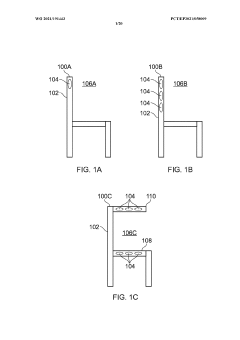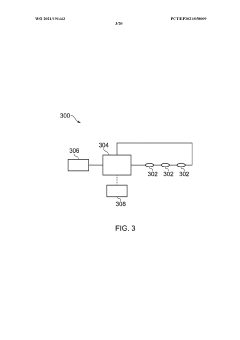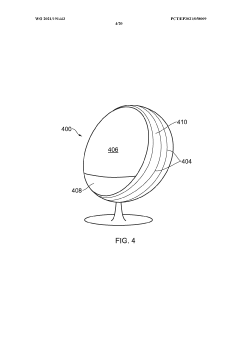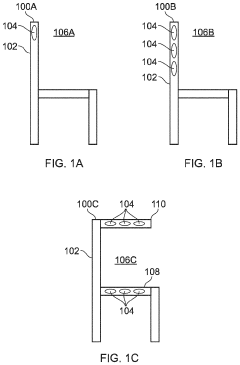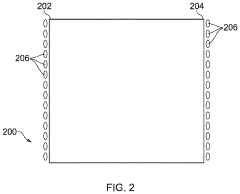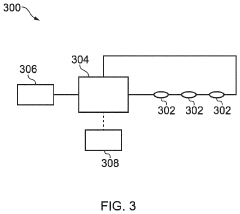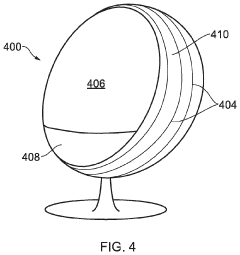Understanding Schumann Resonance: A Natural Signal Modulation
JUN 24, 20259 MIN READ
Generate Your Research Report Instantly with AI Agent
Patsnap Eureka helps you evaluate technical feasibility & market potential.
Schumann Resonance Background and Objectives
Schumann resonances, discovered by physicist Winfried Otto Schumann in 1952, are a set of spectrum peaks in the extremely low frequency (ELF) portion of the Earth's electromagnetic field spectrum. These resonances occur in the Earth-ionosphere cavity, a natural waveguide formed between the Earth's surface and the ionosphere. The fundamental frequency of Schumann resonances is approximately 7.83 Hz, with harmonics at higher frequencies.
The study of Schumann resonances has evolved significantly since their discovery, with applications spanning various scientific disciplines. Initially, these resonances were primarily of interest to atmospheric scientists and geophysicists. However, as research progressed, their relevance expanded to fields such as space weather monitoring, climate change studies, and even potential biological effects on human health.
The primary objective in understanding Schumann resonances is to gain deeper insights into the Earth's electromagnetic environment and its interactions with various natural phenomena. Researchers aim to utilize these resonances as a tool for monitoring global lightning activity, as the resonances are primarily excited by lightning discharges worldwide. This connection provides valuable data for studying global thunderstorm activity and its variations over time.
Another key goal is to investigate the potential use of Schumann resonances as indicators of global climate change. Changes in the Earth's temperature, humidity, and ionospheric conditions can affect the characteristics of these resonances, potentially offering a unique perspective on long-term climate trends.
In recent years, there has been growing interest in exploring the possible biological effects of Schumann resonances. Some researchers hypothesize that these natural electromagnetic oscillations may influence human physiology and cognitive functions, although this remains a controversial area requiring further scientific investigation.
The technological evolution in measurement techniques has significantly enhanced our ability to detect and analyze Schumann resonances. Modern equipment allows for more precise measurements, enabling researchers to study subtle variations and anomalies in these resonances. This improved capability has opened up new avenues for research, including the potential use of Schumann resonances in earthquake prediction and the study of upper atmospheric phenomena.
As we look to the future, the objectives in Schumann resonance research continue to expand. Scientists are exploring innovative applications, such as using these resonances for global positioning systems in situations where traditional GPS might be unavailable. Additionally, there is ongoing research into how Schumann resonances might be utilized in the development of new communication technologies, particularly in the realm of long-distance, low-frequency communications.
The study of Schumann resonances has evolved significantly since their discovery, with applications spanning various scientific disciplines. Initially, these resonances were primarily of interest to atmospheric scientists and geophysicists. However, as research progressed, their relevance expanded to fields such as space weather monitoring, climate change studies, and even potential biological effects on human health.
The primary objective in understanding Schumann resonances is to gain deeper insights into the Earth's electromagnetic environment and its interactions with various natural phenomena. Researchers aim to utilize these resonances as a tool for monitoring global lightning activity, as the resonances are primarily excited by lightning discharges worldwide. This connection provides valuable data for studying global thunderstorm activity and its variations over time.
Another key goal is to investigate the potential use of Schumann resonances as indicators of global climate change. Changes in the Earth's temperature, humidity, and ionospheric conditions can affect the characteristics of these resonances, potentially offering a unique perspective on long-term climate trends.
In recent years, there has been growing interest in exploring the possible biological effects of Schumann resonances. Some researchers hypothesize that these natural electromagnetic oscillations may influence human physiology and cognitive functions, although this remains a controversial area requiring further scientific investigation.
The technological evolution in measurement techniques has significantly enhanced our ability to detect and analyze Schumann resonances. Modern equipment allows for more precise measurements, enabling researchers to study subtle variations and anomalies in these resonances. This improved capability has opened up new avenues for research, including the potential use of Schumann resonances in earthquake prediction and the study of upper atmospheric phenomena.
As we look to the future, the objectives in Schumann resonance research continue to expand. Scientists are exploring innovative applications, such as using these resonances for global positioning systems in situations where traditional GPS might be unavailable. Additionally, there is ongoing research into how Schumann resonances might be utilized in the development of new communication technologies, particularly in the realm of long-distance, low-frequency communications.
Market Applications of Schumann Resonance
Schumann resonances, the natural electromagnetic frequencies of the Earth's ionosphere, have found diverse applications across various market sectors. In the field of geophysics and environmental monitoring, these resonances serve as valuable indicators of global lightning activity and upper atmospheric conditions. Companies specializing in weather forecasting and climate research utilize Schumann resonance data to enhance their predictive models and gain deeper insights into atmospheric dynamics.
The healthcare industry has shown increasing interest in Schumann resonances for their potential therapeutic effects. Some wellness companies have developed products that simulate these natural frequencies, claiming benefits such as stress reduction and improved sleep quality. While scientific evidence supporting these claims remains limited, the market for Schumann resonance-based wellness devices continues to grow, particularly among consumers seeking alternative health solutions.
In the realm of telecommunications, Schumann resonances have applications in long-range communication systems. By leveraging these naturally occurring frequencies, researchers and companies are exploring ways to enhance signal propagation for global communication networks, especially in remote areas where traditional infrastructure is challenging to implement.
The defense and security sector also recognizes the potential of Schumann resonances. These natural signals can be used for submarine communication and as a means of detecting underground nuclear tests. Defense contractors and government agencies invest in research and development to harness these frequencies for secure, long-distance communication and monitoring purposes.
Aerospace and satellite industries utilize Schumann resonance data for ionospheric studies and space weather predictions. Understanding these resonances helps in mitigating the effects of solar storms on satellite operations and improving the accuracy of GPS systems.
In the field of energy exploration, some companies are investigating the use of Schumann resonances for natural resource detection. The variations in these resonances could potentially indicate the presence of underground mineral deposits or oil reserves, offering a non-invasive method for preliminary geological surveys.
The emerging field of Internet of Things (IoT) and smart city technologies is also exploring applications of Schumann resonances. These natural frequencies could potentially serve as a global time reference or synchronization mechanism for widely distributed sensor networks, enhancing the efficiency and reliability of large-scale IoT deployments.
As research in this area continues to advance, new market applications are likely to emerge, spanning fields from environmental conservation to advanced technological systems. The unique properties of Schumann resonances offer opportunities for innovation across multiple industries, driving continued investment and exploration in this fascinating area of natural phenomena.
The healthcare industry has shown increasing interest in Schumann resonances for their potential therapeutic effects. Some wellness companies have developed products that simulate these natural frequencies, claiming benefits such as stress reduction and improved sleep quality. While scientific evidence supporting these claims remains limited, the market for Schumann resonance-based wellness devices continues to grow, particularly among consumers seeking alternative health solutions.
In the realm of telecommunications, Schumann resonances have applications in long-range communication systems. By leveraging these naturally occurring frequencies, researchers and companies are exploring ways to enhance signal propagation for global communication networks, especially in remote areas where traditional infrastructure is challenging to implement.
The defense and security sector also recognizes the potential of Schumann resonances. These natural signals can be used for submarine communication and as a means of detecting underground nuclear tests. Defense contractors and government agencies invest in research and development to harness these frequencies for secure, long-distance communication and monitoring purposes.
Aerospace and satellite industries utilize Schumann resonance data for ionospheric studies and space weather predictions. Understanding these resonances helps in mitigating the effects of solar storms on satellite operations and improving the accuracy of GPS systems.
In the field of energy exploration, some companies are investigating the use of Schumann resonances for natural resource detection. The variations in these resonances could potentially indicate the presence of underground mineral deposits or oil reserves, offering a non-invasive method for preliminary geological surveys.
The emerging field of Internet of Things (IoT) and smart city technologies is also exploring applications of Schumann resonances. These natural frequencies could potentially serve as a global time reference or synchronization mechanism for widely distributed sensor networks, enhancing the efficiency and reliability of large-scale IoT deployments.
As research in this area continues to advance, new market applications are likely to emerge, spanning fields from environmental conservation to advanced technological systems. The unique properties of Schumann resonances offer opportunities for innovation across multiple industries, driving continued investment and exploration in this fascinating area of natural phenomena.
Current State and Challenges in Schumann Resonance Detection
The current state of Schumann Resonance detection has seen significant advancements in recent years, yet it continues to face several challenges. Globally, a network of monitoring stations has been established to continuously measure and analyze these low-frequency electromagnetic waves. These stations utilize highly sensitive magnetometers and specialized antennas to detect the subtle signals emanating from the Earth-ionosphere cavity.
One of the primary challenges in Schumann Resonance detection is the low signal-to-noise ratio. The resonances are extremely weak, typically in the range of a few picoTeslas, making them susceptible to interference from both natural and anthropogenic sources. This necessitates the use of sophisticated signal processing techniques and noise reduction algorithms to extract meaningful data.
Another significant hurdle is the variability of the resonances due to solar activity, seasonal changes, and local weather conditions. These factors can alter the characteristics of the Earth-ionosphere cavity, affecting the frequency and amplitude of the resonances. Researchers must account for these variations when interpreting the data, which requires complex modeling and long-term observations.
The geographical distribution of detection stations poses another challenge. While there are several well-established stations in Europe and North America, there is a notable lack of coverage in other parts of the world, particularly in oceanic and polar regions. This uneven distribution limits our ability to create a comprehensive global picture of Schumann Resonances.
Technological limitations also play a role in the current state of detection. The need for extremely sensitive equipment that can operate reliably in various environmental conditions presents ongoing engineering challenges. Additionally, the requirement for continuous, high-resolution data collection and storage creates significant data management and processing demands.
Despite these challenges, recent advancements in sensor technology and data analysis techniques have improved our ability to detect and study Schumann Resonances. Machine learning algorithms are increasingly being employed to enhance signal detection and classification, while improvements in hardware have led to more compact and efficient monitoring systems.
The scientific community is actively working to address these challenges through international collaborations, standardization of measurement protocols, and the development of new detection technologies. These efforts aim to enhance our understanding of Schumann Resonances and their potential applications in fields such as global lightning detection, space weather monitoring, and even earthquake prediction.
One of the primary challenges in Schumann Resonance detection is the low signal-to-noise ratio. The resonances are extremely weak, typically in the range of a few picoTeslas, making them susceptible to interference from both natural and anthropogenic sources. This necessitates the use of sophisticated signal processing techniques and noise reduction algorithms to extract meaningful data.
Another significant hurdle is the variability of the resonances due to solar activity, seasonal changes, and local weather conditions. These factors can alter the characteristics of the Earth-ionosphere cavity, affecting the frequency and amplitude of the resonances. Researchers must account for these variations when interpreting the data, which requires complex modeling and long-term observations.
The geographical distribution of detection stations poses another challenge. While there are several well-established stations in Europe and North America, there is a notable lack of coverage in other parts of the world, particularly in oceanic and polar regions. This uneven distribution limits our ability to create a comprehensive global picture of Schumann Resonances.
Technological limitations also play a role in the current state of detection. The need for extremely sensitive equipment that can operate reliably in various environmental conditions presents ongoing engineering challenges. Additionally, the requirement for continuous, high-resolution data collection and storage creates significant data management and processing demands.
Despite these challenges, recent advancements in sensor technology and data analysis techniques have improved our ability to detect and study Schumann Resonances. Machine learning algorithms are increasingly being employed to enhance signal detection and classification, while improvements in hardware have led to more compact and efficient monitoring systems.
The scientific community is actively working to address these challenges through international collaborations, standardization of measurement protocols, and the development of new detection technologies. These efforts aim to enhance our understanding of Schumann Resonances and their potential applications in fields such as global lightning detection, space weather monitoring, and even earthquake prediction.
Existing Methods for Schumann Resonance Measurement
01 Schumann resonance signal generation and modulation
Techniques for generating and modulating Schumann resonance signals are developed. These methods involve creating artificial electromagnetic fields that mimic or interact with the Earth's natural Schumann resonances. The modulation can be used for various applications, including communication, health, and environmental monitoring.- Schumann resonance signal generation and modulation: Techniques for generating and modulating Schumann resonance signals are developed. These methods involve creating artificial electromagnetic fields that mimic or interact with the Earth's natural Schumann resonances. The modulation can be used for various applications, including health, communication, and environmental monitoring.
- Therapeutic applications of modulated Schumann resonance: Modulated Schumann resonance signals are utilized in therapeutic devices and methods. These applications aim to improve human health and well-being by exposing individuals to controlled electromagnetic fields that resonate with the Earth's natural frequencies. The devices may be used for stress reduction, sleep improvement, and overall health enhancement.
- Communication systems using Schumann resonance: Innovative communication systems are developed using Schumann resonance signal modulation. These systems leverage the Earth's natural electromagnetic cavity to transmit information over long distances with low power requirements. Applications include global communication networks and underwater or underground signal transmission.
- Environmental monitoring and prediction using Schumann resonance: Schumann resonance signal modulation is employed in environmental monitoring and prediction systems. By analyzing changes in the Earth's electromagnetic field, these systems can detect and forecast various phenomena, including seismic activity, weather patterns, and ionospheric disturbances.
- Schumann resonance signal amplification and filtering: Advanced techniques for amplifying and filtering Schumann resonance signals are developed. These methods improve the detection and analysis of weak electromagnetic signals, enabling more accurate measurements of the Earth's natural resonances and their variations. Applications include scientific research, geophysical exploration, and electromagnetic compatibility testing.
02 Schumann resonance-based therapeutic devices
Devices that utilize Schumann resonance frequencies for therapeutic purposes are designed. These devices aim to improve human health and well-being by exposing users to electromagnetic fields that match or harmonize with the Earth's natural frequencies. Applications include stress reduction, sleep improvement, and overall wellness enhancement.Expand Specific Solutions03 Schumann resonance detection and measurement systems
Systems and methods for detecting and measuring Schumann resonance signals are developed. These technologies enable precise monitoring of natural electromagnetic phenomena and can be used for scientific research, environmental monitoring, and potential early warning systems for natural disasters.Expand Specific Solutions04 Integration of Schumann resonance in communication systems
Innovative approaches to incorporate Schumann resonance frequencies into communication systems are explored. These methods aim to enhance signal propagation, improve communication reliability, or develop novel communication channels using the Earth's natural electromagnetic environment.Expand Specific Solutions05 Schumann resonance-based energy harvesting
Technologies for harvesting energy from Schumann resonance fields are investigated. These systems aim to capture and convert the extremely low-frequency electromagnetic energy of the Earth's resonant cavity into usable electrical power, potentially offering a new source of renewable energy.Expand Specific Solutions
Key Players in Schumann Resonance Studies
The field of Schumann Resonance signal modulation is in its early development stage, with growing interest from both academic and industrial sectors. The market size is relatively small but expanding, driven by potential applications in environmental monitoring, telecommunications, and health sciences. Technologically, it's still in the emerging phase, with varying levels of maturity across different applications. Companies like Telefonaktiebolaget LM Ericsson, Samsung Electronics Co., Ltd., and IBM are leading in research and development, while academic institutions such as Hangzhou Dianzi University and the University of Bern are contributing significant theoretical advancements. The involvement of diverse players, from telecommunications giants to specialized research institutes, indicates a competitive landscape with ample room for innovation and market growth.
Telefonaktiebolaget LM Ericsson
Technical Solution: Ericsson has developed a novel approach to utilizing Schumann Resonance for improving wireless communication systems. Their technology involves integrating SR detection capabilities into existing cellular network infrastructure. By monitoring SR fluctuations, Ericsson's system can dynamically adjust signal modulation and transmission parameters to optimize communication quality and reliability. This approach also explores the potential of using SR as a natural carrier wave for long-distance, low-power communication, particularly in remote areas or during emergency situations where traditional infrastructure may be compromised.
Strengths: Integration with existing infrastructure, potential for improved global connectivity. Weaknesses: Susceptibility to natural SR variations, potential interference with other systems.
Samsung Electronics Co., Ltd.
Technical Solution: Samsung has developed a miniaturized Schumann Resonance detector for integration into consumer electronics. This technology allows smartphones and wearable devices to monitor SR fluctuations and correlate them with various environmental and physiological factors. Samsung's approach includes using SR data to enhance the accuracy of GPS positioning, improve weather predictions on a local scale, and potentially monitor personal health metrics. The company is also exploring the use of SR signals for secure, low-bandwidth communication between IoT devices, leveraging the global nature of the Schumann Resonance phenomenon.
Strengths: Consumer-level application, potential for widespread adoption. Weaknesses: Limited sensitivity compared to specialized equipment, potential privacy concerns.
Core Technologies in Schumann Resonance Analysis
A magnetic field exposure system and uses thereof
PatentWO2021191443A1
Innovation
- A magnetic field exposure system generating an amplitude-modulated low frequency magnetic field with a carrier frequency of 360 to 450 Hz and a modulation frequency of 0.5 to 100 Hz, with a field strength of 0.5 to 250 mT, specifically designed to expose organic cells or tissues to improve cell survival, proliferation, reduce stress, and enhance well-being.
A magnetic field exposure system and uses thereof
PatentPendingUS20230372726A1
Innovation
- A magnetic field exposure system generating an amplitude-modulated low frequency magnetic field with a carrier frequency of 360 to 450 Hz and a modulation frequency of 0.5 to 100 Hz, providing a field strength of 0.5 to 250 μT, specifically designed to enhance cell survival, proliferation, reduce stress, and promote tissue regeneration.
Environmental Factors Affecting Schumann Resonance
The Schumann resonance, a natural electromagnetic phenomenon occurring in the Earth's ionosphere, is influenced by various environmental factors that can modulate its characteristics. These factors play a crucial role in shaping the resonance's frequency, amplitude, and overall behavior.
One of the primary environmental factors affecting Schumann resonance is solar activity. Solar flares and coronal mass ejections can significantly impact the ionosphere's properties, altering its conductivity and electron density. These changes, in turn, affect the propagation of electromagnetic waves within the Earth-ionosphere cavity, leading to variations in the observed Schumann resonance frequencies and amplitudes.
Seasonal changes also contribute to the modulation of Schumann resonance. The Earth's tilt and its orbit around the Sun result in varying levels of solar radiation reaching different parts of the planet throughout the year. This seasonal variation affects the ionosphere's composition and structure, consequently influencing the Schumann resonance characteristics.
Global lightning activity is another critical environmental factor. As the primary source of excitation for Schumann resonance, changes in global thunderstorm patterns can significantly impact the resonance's intensity and frequency distribution. Seasonal shifts in lightning activity, particularly in tropical regions, can lead to observable variations in Schumann resonance measurements.
Atmospheric conditions, such as temperature, humidity, and pressure, also play a role in modulating Schumann resonance. These factors can affect the conductivity of the lower atmosphere and influence the propagation of electromagnetic waves, thereby impacting the resonance characteristics.
Geomagnetic activity, driven by interactions between the Earth's magnetic field and the solar wind, can cause disturbances in the ionosphere. These disturbances can lead to changes in the Schumann resonance, particularly during geomagnetic storms or other space weather events.
Human activities, while less significant compared to natural factors, can also influence Schumann resonance. Electromagnetic pollution from power lines, radio transmissions, and other artificial sources may introduce noise and potentially affect the detection and analysis of Schumann resonance signals.
Understanding these environmental factors and their complex interactions is crucial for accurately interpreting Schumann resonance data and leveraging this natural phenomenon for various applications, such as global lightning monitoring, space weather studies, and potential early warning systems for natural disasters.
One of the primary environmental factors affecting Schumann resonance is solar activity. Solar flares and coronal mass ejections can significantly impact the ionosphere's properties, altering its conductivity and electron density. These changes, in turn, affect the propagation of electromagnetic waves within the Earth-ionosphere cavity, leading to variations in the observed Schumann resonance frequencies and amplitudes.
Seasonal changes also contribute to the modulation of Schumann resonance. The Earth's tilt and its orbit around the Sun result in varying levels of solar radiation reaching different parts of the planet throughout the year. This seasonal variation affects the ionosphere's composition and structure, consequently influencing the Schumann resonance characteristics.
Global lightning activity is another critical environmental factor. As the primary source of excitation for Schumann resonance, changes in global thunderstorm patterns can significantly impact the resonance's intensity and frequency distribution. Seasonal shifts in lightning activity, particularly in tropical regions, can lead to observable variations in Schumann resonance measurements.
Atmospheric conditions, such as temperature, humidity, and pressure, also play a role in modulating Schumann resonance. These factors can affect the conductivity of the lower atmosphere and influence the propagation of electromagnetic waves, thereby impacting the resonance characteristics.
Geomagnetic activity, driven by interactions between the Earth's magnetic field and the solar wind, can cause disturbances in the ionosphere. These disturbances can lead to changes in the Schumann resonance, particularly during geomagnetic storms or other space weather events.
Human activities, while less significant compared to natural factors, can also influence Schumann resonance. Electromagnetic pollution from power lines, radio transmissions, and other artificial sources may introduce noise and potentially affect the detection and analysis of Schumann resonance signals.
Understanding these environmental factors and their complex interactions is crucial for accurately interpreting Schumann resonance data and leveraging this natural phenomenon for various applications, such as global lightning monitoring, space weather studies, and potential early warning systems for natural disasters.
Potential Health Implications of Schumann Resonance
The potential health implications of Schumann Resonance have garnered significant attention in recent years, with researchers exploring its possible effects on human physiology and well-being. Schumann Resonance, a set of spectrum peaks in the extremely low frequency (ELF) portion of the Earth's electromagnetic field, has been hypothesized to influence various biological processes.
One area of interest is the potential impact of Schumann Resonance on circadian rhythms. Some studies suggest that these natural electromagnetic frequencies may play a role in regulating sleep-wake cycles and other biological rhythms. Researchers have observed correlations between variations in Schumann Resonance and changes in melatonin levels, which are crucial for maintaining healthy sleep patterns.
Another aspect under investigation is the possible influence of Schumann Resonance on cognitive function and mental health. Preliminary studies have indicated that exposure to frequencies similar to Schumann Resonance may affect brain activity, potentially influencing mood, attention, and overall cognitive performance. However, these findings remain controversial and require further rigorous scientific validation.
The relationship between Schumann Resonance and the human immune system is also being explored. Some researchers propose that these natural electromagnetic frequencies may play a role in modulating immune responses, potentially affecting overall health and resistance to diseases. However, the mechanisms behind this potential connection are not yet fully understood and require additional research.
Cardiovascular health is another area where Schumann Resonance may have implications. Some studies have suggested a correlation between changes in Schumann Resonance and variations in heart rate variability, a key indicator of cardiovascular health. This has led to speculation about the potential use of Schumann Resonance-based therapies for certain cardiovascular conditions.
It is important to note that while these potential health implications are intriguing, much of the research in this field is still in its early stages. Many studies have been small-scale or observational, and larger, more controlled trials are needed to establish definitive causal relationships. Additionally, the mechanisms by which Schumann Resonance might influence human health are not yet fully elucidated, necessitating further investigation at the cellular and molecular levels.
As research in this area continues to evolve, it is crucial to approach claims about the health benefits of Schumann Resonance with scientific rigor and skepticism. While the potential implications are fascinating, more comprehensive studies are required to fully understand the role of these natural electromagnetic frequencies in human health and to develop any potential therapeutic applications.
One area of interest is the potential impact of Schumann Resonance on circadian rhythms. Some studies suggest that these natural electromagnetic frequencies may play a role in regulating sleep-wake cycles and other biological rhythms. Researchers have observed correlations between variations in Schumann Resonance and changes in melatonin levels, which are crucial for maintaining healthy sleep patterns.
Another aspect under investigation is the possible influence of Schumann Resonance on cognitive function and mental health. Preliminary studies have indicated that exposure to frequencies similar to Schumann Resonance may affect brain activity, potentially influencing mood, attention, and overall cognitive performance. However, these findings remain controversial and require further rigorous scientific validation.
The relationship between Schumann Resonance and the human immune system is also being explored. Some researchers propose that these natural electromagnetic frequencies may play a role in modulating immune responses, potentially affecting overall health and resistance to diseases. However, the mechanisms behind this potential connection are not yet fully understood and require additional research.
Cardiovascular health is another area where Schumann Resonance may have implications. Some studies have suggested a correlation between changes in Schumann Resonance and variations in heart rate variability, a key indicator of cardiovascular health. This has led to speculation about the potential use of Schumann Resonance-based therapies for certain cardiovascular conditions.
It is important to note that while these potential health implications are intriguing, much of the research in this field is still in its early stages. Many studies have been small-scale or observational, and larger, more controlled trials are needed to establish definitive causal relationships. Additionally, the mechanisms by which Schumann Resonance might influence human health are not yet fully elucidated, necessitating further investigation at the cellular and molecular levels.
As research in this area continues to evolve, it is crucial to approach claims about the health benefits of Schumann Resonance with scientific rigor and skepticism. While the potential implications are fascinating, more comprehensive studies are required to fully understand the role of these natural electromagnetic frequencies in human health and to develop any potential therapeutic applications.
Unlock deeper insights with Patsnap Eureka Quick Research — get a full tech report to explore trends and direct your research. Try now!
Generate Your Research Report Instantly with AI Agent
Supercharge your innovation with Patsnap Eureka AI Agent Platform!
